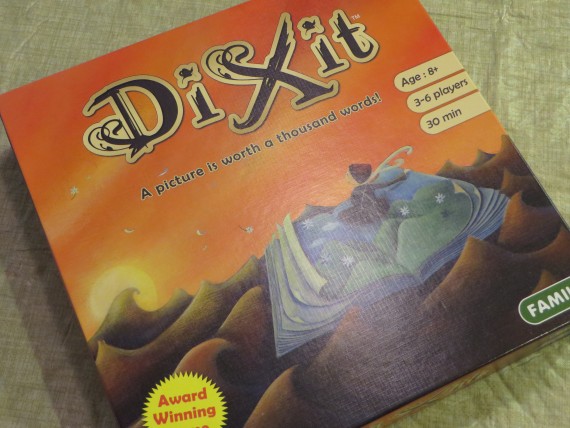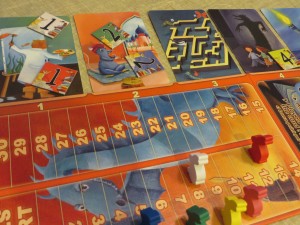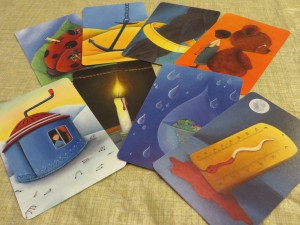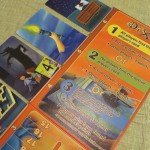Game Review: Dixit
There’s no doubt that, between my wife and I, I’m the more left-brained and strategy-focused of us. Mrs. Blogadin, being a graphic designer, is absolutely the more right-brained in our marriage. Any game, therefore, where I find myself having severely lost to my lovely wife causes me to pause and take notice.
Dixit is one of those games.
Summary
Dixit is a simple game for 3-6 players where you attempt to get people to choose your card submissions over others, similar to Cards Against Humanity or Balderdash. To play, each player takes six cards from the deck, each of which has unique art on it (art styles range from something you might see in a hotel, to something you might envision in a psychadelic dream). One player – the active player – then chooses a card from his hand, places it face down in front of him on the table, and says a clue about the card. The other players then choose a card from their respective hands that best represents that clue and place them face down on the table as well. Once all players have chosen a card and placed it on the table, the active player takes all the face down cards, looks at them, and arranges them face up for the players to see. The players then place markers on the card they believe belongs to the active player.
Points are awarded each round based on card selection. If you are not the active player, you get points based on how many players chose your card, as well as whether or not you correctly chose the active player’s card. If you’re the active player, it’s a little more complicated. As long as at least one player, but not all players, choose your card, you earn points. If, however, everyone chooses the active player’s card, OR if nobody chooses the active player’s card, the active player gets zero points! The goal of the active player, therefore, is to make the clue clear enough that at least one player chooses the correct card, but obscure enough that at least one player chooses a wrong card.
After each round, all the used art cards are discarded, and each player draws back up to six cards. A successful round for any given player will net 2-4 points per round (on average), and a player wins once 30 points are earned. The base game comes with 84 art cards; each of the three expansions has over 70 additional cards to add.
The Good
The art. For a game based on art, you need to have good art! This game doesn’t let you down. The cards range from simple to interesting to flat out weird, but all have the same, family-accessible style.
The hook. While the game is based on art, it isn’t *about* art, but rather the clues you come up with to sell only a portion of the crowd. While it doesn’t seem like there would be much strategy involved in clue-giving, there are absolutely ways to help ensure that only a portion of the audience properly decodes your clue. The better you know your fellow players, the better you should be able to score.
The components and packaging. Rarely does packaging get a nod from me, but this is one of the few instances where it’s a definite plus. The base set allows for all three expansions to be neatly stored in the plastic insert, so one, thin box contains the whole game with proper organization. Additionally, the game board is printed such that the scoring system is right in front of all players – no need to have to constantly flip back to the rulesheet to remember how to score!
The Bad
Lack of overall depth. While coming up with good, creative, winning clues is key to winning the game, there’s not much depth beyond that. In some ways, that’s a plus – this helps make the game great for families and fans of light games. For my tastes, however, I’d like to see a little more depth, even for a light game. At least a game like Cards Against Humanity allows you to create your own cards, and has 2- and 3-blank cards to change things up slightly.
The art. This is both a plus and a minus. The art for Dixit is nice and of a story-telling nature. As with the gameplay, though, there’s not a lot of variety, even amongst the different expansions – while the themes are a little different across the expansions, the style is all the same. I’d love to see series of expansions in various styles…avante garde, cubism, abstract, etc.
The Wrap-Up
By the time the tallies were taken, my wife had nearly doubled-up the entire field, with her scoring 30 to our 16 or less, and I have no doubt she’ll continue to eat my lunch in future sessions. Mrs. Blogadin is definitely a fan of lighter games, party games, and games that are heavier on story than mechanics. Featuring a simple mechanic and thematic art, Dixit absolutely fits the bill. The game is a great game for families or classrooms, and for dedicated gamers it makes for a nice opener to a longer game night. Although the gameplay is ultimately a little thin, it is still worthy of a place in your game closet, if for no other reason than a quality change-of-pace.
The Score: 6.5/10
Game: Dixit
Year: 2008
Designers: Regis Bonnessee
Publisher: Asmodee
Players: 3-6 (best with 4 or more)
Game Length: 20-40 minutes
← I Acquired Firefly Because of my Personal Prime Directive




